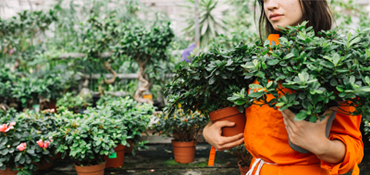Caring for home flowers
Caring for home flowers can be a rewarding experience, filling your indoor spaces with color, fragrance, and life. With the right care, your flowers can thrive and bring joy to your home year-round. Here are some essential tips and practices for keeping your home flowers healthy and beautiful.
1. Choosing the Right Flowers
Start by selecting flowers that are well-suited to indoor conditions:
- Light Requirements: Choose flowers that match the light availability in your home. Some flowers need bright, direct sunlight, while others thrive in low-light conditions.
- Temperature and Humidity: Consider the typical indoor climate of your home. Some flowers prefer warm, humid environments, while others are more tolerant of cooler, drier air.
2. Proper Potting
Correct potting is crucial for the health of your flowers:
- Soil: Use high-quality potting soil that provides good drainage and nutrients. Avoid garden soil, which can be too heavy and retain too much moisture.
- Containers: Select pots with drainage holes to prevent water from accumulating at the bottom, which can cause root rot. Ensure the pot size is appropriate for the flower’s growth.
3. Watering
Watering needs vary depending on the type of flower:
- Frequency: Water your flowers when the top inch of soil feels dry. Overwatering can be just as harmful as underwatering.
- Method: Water thoroughly until excess water drains out of the bottom of the pot. Discard any water that collects in the saucer to prevent root rot.
- Humidity: Increase humidity for flowers that thrive in moist environments by misting them regularly or placing a tray of water nearby.
4. Fertilizing
Fertilizing provides essential nutrients for growth:
- Type: Use a balanced, water-soluble fertilizer specifically formulated for flowering plants.
- Schedule: Fertilize your flowers every 4-6 weeks during the growing season (spring and summer). Reduce or stop fertilizing during the dormant season (fall and winter).
5. Light Management
Light is a critical factor for indoor flowers:
- Placement: Position flowers near windows where they can receive adequate light. South-facing windows typically provide the most light.
- Supplemental Lighting: If natural light is insufficient, use grow lights to provide the necessary light spectrum for photosynthesis.
6. Pruning and Deadheading
Regular pruning and deadheading encourage healthy growth and blooming:
- Pruning: Remove dead or yellowing leaves and stems to promote air circulation and prevent disease.
- Deadheading: Pinch or cut off spent flowers to redirect energy towards new growth and extend the blooming period.
7. Pest Control
Indoor flowers can attract pests that need to be managed promptly:
- Inspection: Regularly check your flowers for signs of pests like aphids, spider mites, and mealybugs.
- Treatment: Use natural remedies like neem oil or insecticidal soap to treat infestations. Keep the plant isolated until the pests are under control.
8. Repotting
Repotting is necessary when flowers outgrow their containers:
- Frequency: Repot your flowers every 1-2 years or when you notice roots growing out of the drainage holes.
- Procedure: Gently remove the plant from its current pot, trim any dead roots, and place it in a slightly larger pot with fresh potting soil.
9. Seasonal Care
Adjust care routines to match the seasons:
- Spring and Summer: Increase watering and fertilizing as plants enter their active growth phase.
- Fall and Winter: Reduce watering and stop fertilizing as plants go dormant. Ensure they receive sufficient light, as daylight hours decrease.
10. Enjoying Your Flowers
Finally, take time to enjoy the beauty and fragrance of your home flowers:
- Display: Arrange flowers in decorative pots and place them where you can appreciate their beauty daily.
- Care Routine: Establish a regular care routine to check on your flowers’ needs and enjoy the process of nurturing them.
By following these guidelines, you can ensure that your home flowers remain healthy, vibrant, and a source of joy throughout the year. Happy gardening!



Leave A Reply